A Review of Herbal Medicines for Pain Relief & Nursing Implications
VerifiedAdded on 2023/06/15
|5
|925
|323
Report
AI Summary
This report provides a comprehensive overview of herbal medicines used for pain relief, focusing on chamomile, kava kava, and capsaicin. It details their potential side effects, medicinal interactions, and essential nursing implications for patient care. The report emphasizes the importance of nursing assessments, including monitoring anxiety levels, skin reactions, pain intensity, and sleep patterns. It also highlights the significance of identifying potential drug interactions and addressing cultural factors that may influence a patient's pain experience, ensuring patient safety and promoting effective pain management. This student contributed assignment is available on Desklib, a platform offering study tools and resources.
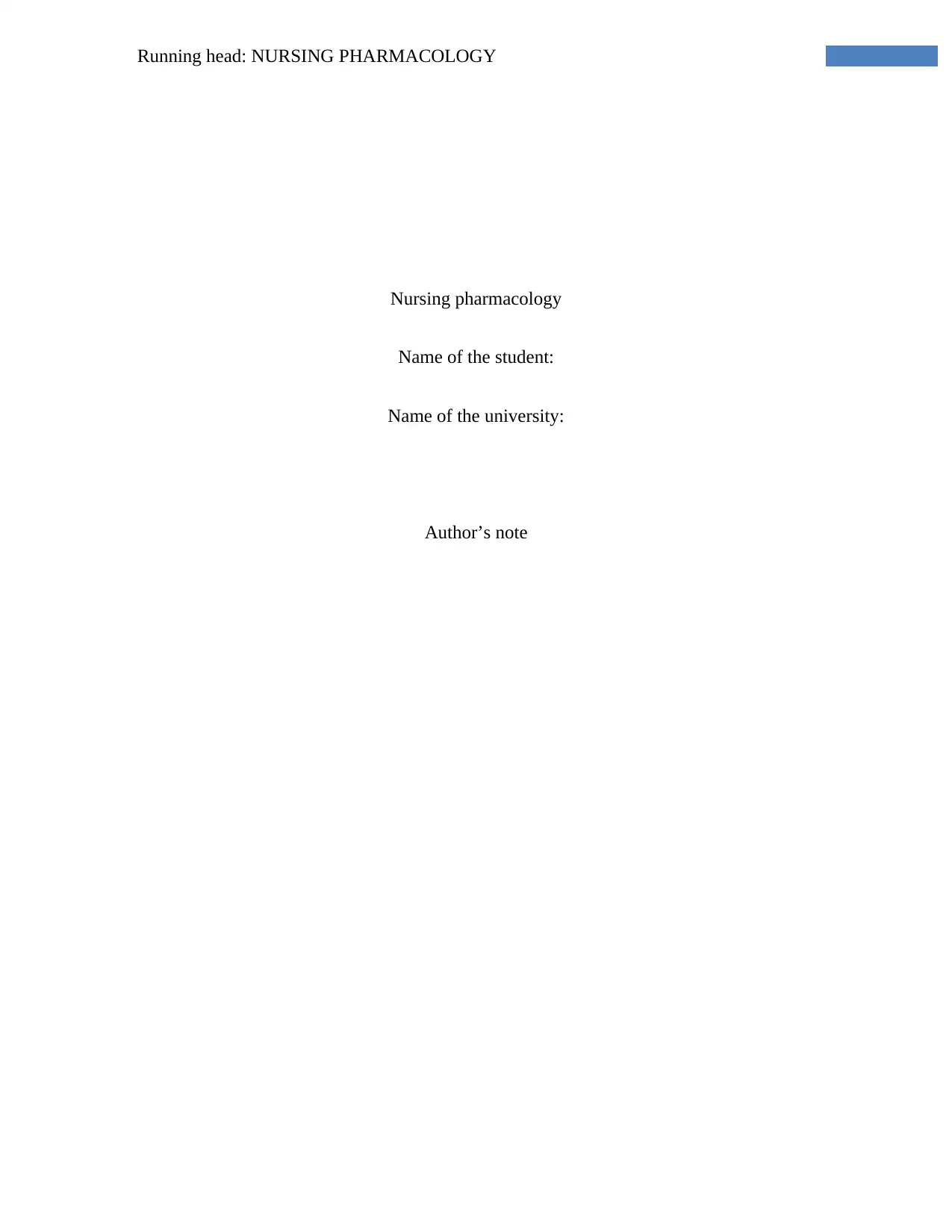
Running head: NURSING PHARMACOLOGY
Nursing pharmacology
Name of the student:
Name of the university:
Author’s note
Nursing pharmacology
Name of the student:
Name of the university:
Author’s note
Paraphrase This Document
Need a fresh take? Get an instant paraphrase of this document with our AI Paraphraser
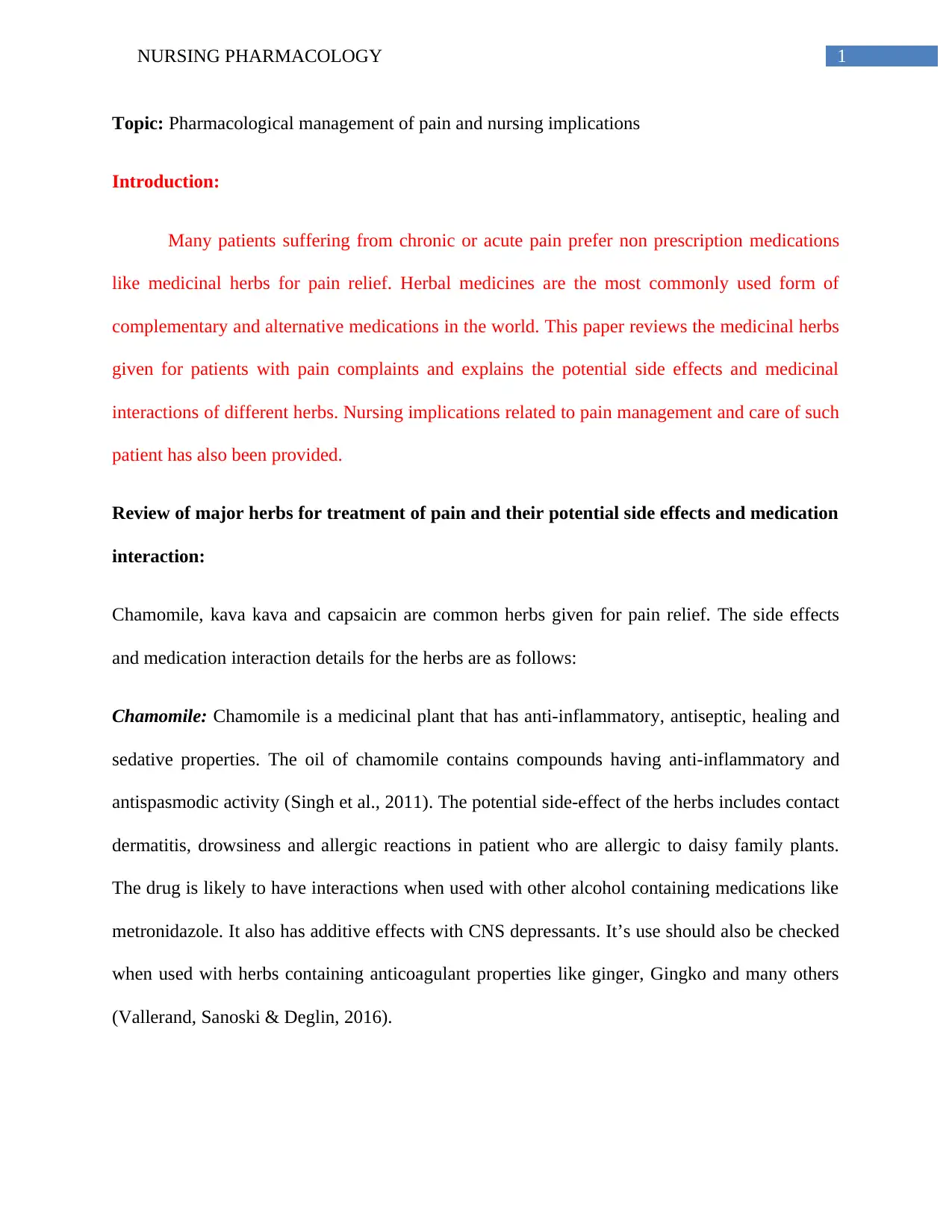
1NURSING PHARMACOLOGY
Topic: Pharmacological management of pain and nursing implications
Introduction:
Many patients suffering from chronic or acute pain prefer non prescription medications
like medicinal herbs for pain relief. Herbal medicines are the most commonly used form of
complementary and alternative medications in the world. This paper reviews the medicinal herbs
given for patients with pain complaints and explains the potential side effects and medicinal
interactions of different herbs. Nursing implications related to pain management and care of such
patient has also been provided.
Review of major herbs for treatment of pain and their potential side effects and medication
interaction:
Chamomile, kava kava and capsaicin are common herbs given for pain relief. The side effects
and medication interaction details for the herbs are as follows:
Chamomile: Chamomile is a medicinal plant that has anti-inflammatory, antiseptic, healing and
sedative properties. The oil of chamomile contains compounds having anti-inflammatory and
antispasmodic activity (Singh et al., 2011). The potential side-effect of the herbs includes contact
dermatitis, drowsiness and allergic reactions in patient who are allergic to daisy family plants.
The drug is likely to have interactions when used with other alcohol containing medications like
metronidazole. It also has additive effects with CNS depressants. It’s use should also be checked
when used with herbs containing anticoagulant properties like ginger, Gingko and many others
(Vallerand, Sanoski & Deglin, 2016).
Topic: Pharmacological management of pain and nursing implications
Introduction:
Many patients suffering from chronic or acute pain prefer non prescription medications
like medicinal herbs for pain relief. Herbal medicines are the most commonly used form of
complementary and alternative medications in the world. This paper reviews the medicinal herbs
given for patients with pain complaints and explains the potential side effects and medicinal
interactions of different herbs. Nursing implications related to pain management and care of such
patient has also been provided.
Review of major herbs for treatment of pain and their potential side effects and medication
interaction:
Chamomile, kava kava and capsaicin are common herbs given for pain relief. The side effects
and medication interaction details for the herbs are as follows:
Chamomile: Chamomile is a medicinal plant that has anti-inflammatory, antiseptic, healing and
sedative properties. The oil of chamomile contains compounds having anti-inflammatory and
antispasmodic activity (Singh et al., 2011). The potential side-effect of the herbs includes contact
dermatitis, drowsiness and allergic reactions in patient who are allergic to daisy family plants.
The drug is likely to have interactions when used with other alcohol containing medications like
metronidazole. It also has additive effects with CNS depressants. It’s use should also be checked
when used with herbs containing anticoagulant properties like ginger, Gingko and many others
(Vallerand, Sanoski & Deglin, 2016).
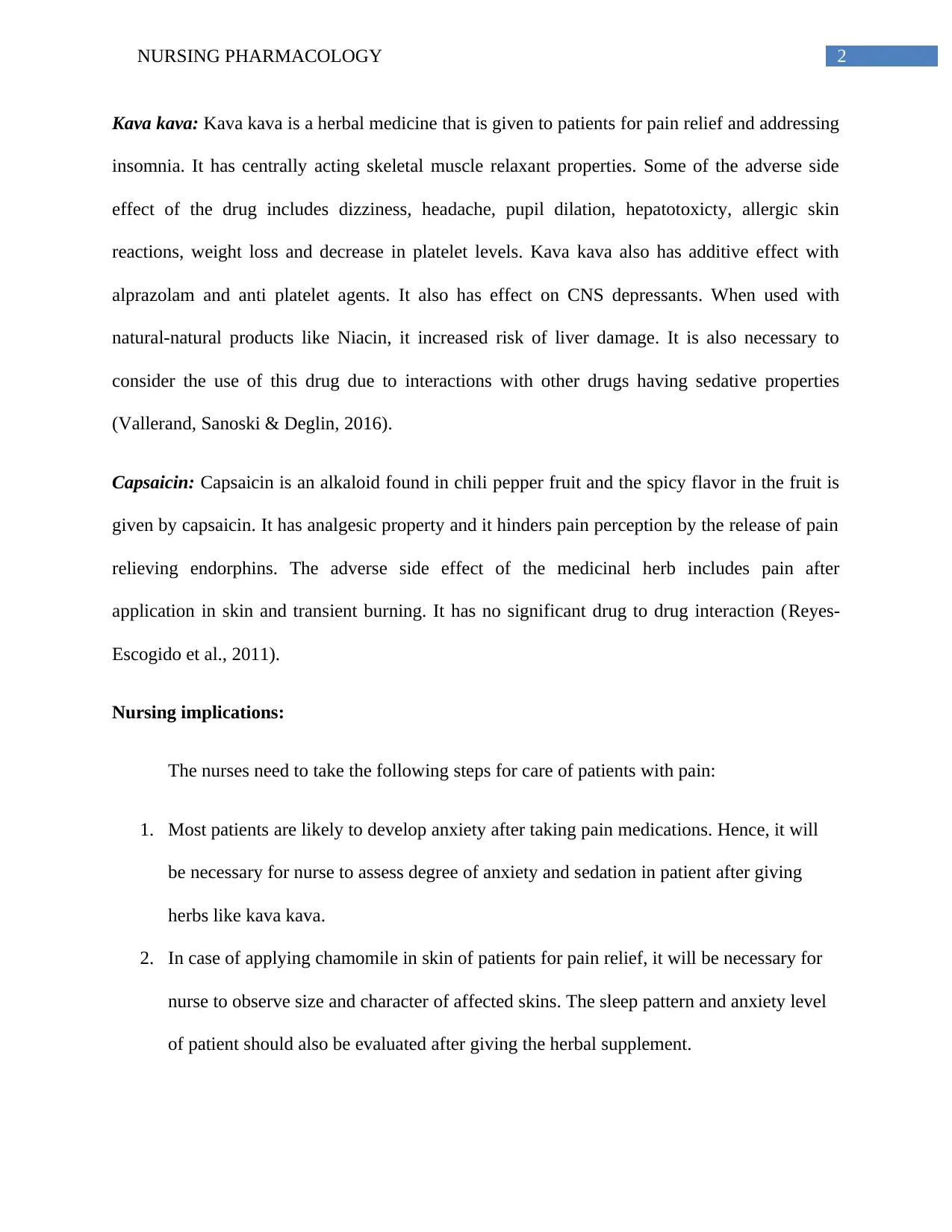
2NURSING PHARMACOLOGY
Kava kava: Kava kava is a herbal medicine that is given to patients for pain relief and addressing
insomnia. It has centrally acting skeletal muscle relaxant properties. Some of the adverse side
effect of the drug includes dizziness, headache, pupil dilation, hepatotoxicty, allergic skin
reactions, weight loss and decrease in platelet levels. Kava kava also has additive effect with
alprazolam and anti platelet agents. It also has effect on CNS depressants. When used with
natural-natural products like Niacin, it increased risk of liver damage. It is also necessary to
consider the use of this drug due to interactions with other drugs having sedative properties
(Vallerand, Sanoski & Deglin, 2016).
Capsaicin: Capsaicin is an alkaloid found in chili pepper fruit and the spicy flavor in the fruit is
given by capsaicin. It has analgesic property and it hinders pain perception by the release of pain
relieving endorphins. The adverse side effect of the medicinal herb includes pain after
application in skin and transient burning. It has no significant drug to drug interaction (Reyes-
Escogido et al., 2011).
Nursing implications:
The nurses need to take the following steps for care of patients with pain:
1. Most patients are likely to develop anxiety after taking pain medications. Hence, it will
be necessary for nurse to assess degree of anxiety and sedation in patient after giving
herbs like kava kava.
2. In case of applying chamomile in skin of patients for pain relief, it will be necessary for
nurse to observe size and character of affected skins. The sleep pattern and anxiety level
of patient should also be evaluated after giving the herbal supplement.
Kava kava: Kava kava is a herbal medicine that is given to patients for pain relief and addressing
insomnia. It has centrally acting skeletal muscle relaxant properties. Some of the adverse side
effect of the drug includes dizziness, headache, pupil dilation, hepatotoxicty, allergic skin
reactions, weight loss and decrease in platelet levels. Kava kava also has additive effect with
alprazolam and anti platelet agents. It also has effect on CNS depressants. When used with
natural-natural products like Niacin, it increased risk of liver damage. It is also necessary to
consider the use of this drug due to interactions with other drugs having sedative properties
(Vallerand, Sanoski & Deglin, 2016).
Capsaicin: Capsaicin is an alkaloid found in chili pepper fruit and the spicy flavor in the fruit is
given by capsaicin. It has analgesic property and it hinders pain perception by the release of pain
relieving endorphins. The adverse side effect of the medicinal herb includes pain after
application in skin and transient burning. It has no significant drug to drug interaction (Reyes-
Escogido et al., 2011).
Nursing implications:
The nurses need to take the following steps for care of patients with pain:
1. Most patients are likely to develop anxiety after taking pain medications. Hence, it will
be necessary for nurse to assess degree of anxiety and sedation in patient after giving
herbs like kava kava.
2. In case of applying chamomile in skin of patients for pain relief, it will be necessary for
nurse to observe size and character of affected skins. The sleep pattern and anxiety level
of patient should also be evaluated after giving the herbal supplement.
⊘ This is a preview!⊘
Do you want full access?
Subscribe today to unlock all pages.

Trusted by 1+ million students worldwide
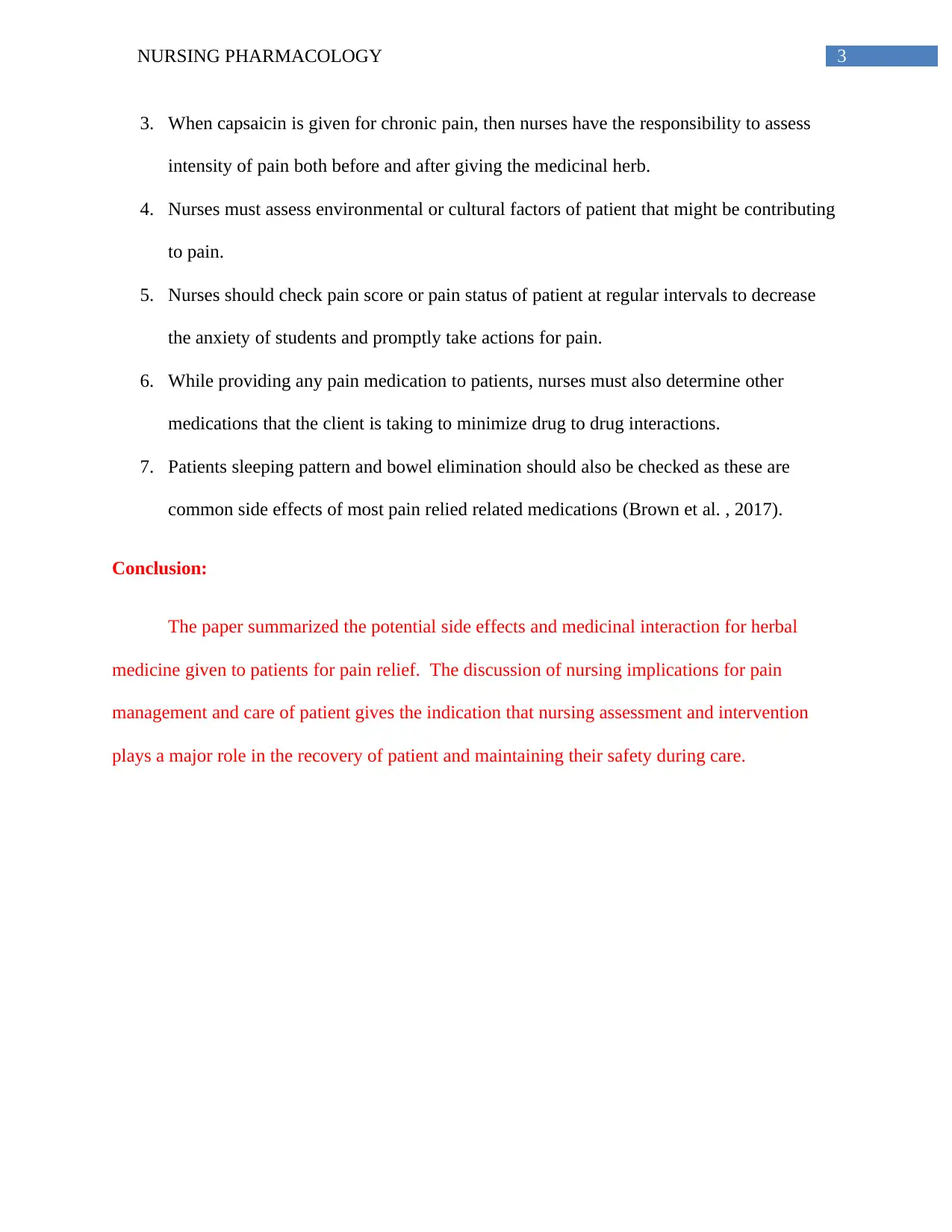
3NURSING PHARMACOLOGY
3. When capsaicin is given for chronic pain, then nurses have the responsibility to assess
intensity of pain both before and after giving the medicinal herb.
4. Nurses must assess environmental or cultural factors of patient that might be contributing
to pain.
5. Nurses should check pain score or pain status of patient at regular intervals to decrease
the anxiety of students and promptly take actions for pain.
6. While providing any pain medication to patients, nurses must also determine other
medications that the client is taking to minimize drug to drug interactions.
7. Patients sleeping pattern and bowel elimination should also be checked as these are
common side effects of most pain relied related medications (Brown et al. , 2017).
Conclusion:
The paper summarized the potential side effects and medicinal interaction for herbal
medicine given to patients for pain relief. The discussion of nursing implications for pain
management and care of patient gives the indication that nursing assessment and intervention
plays a major role in the recovery of patient and maintaining their safety during care.
3. When capsaicin is given for chronic pain, then nurses have the responsibility to assess
intensity of pain both before and after giving the medicinal herb.
4. Nurses must assess environmental or cultural factors of patient that might be contributing
to pain.
5. Nurses should check pain score or pain status of patient at regular intervals to decrease
the anxiety of students and promptly take actions for pain.
6. While providing any pain medication to patients, nurses must also determine other
medications that the client is taking to minimize drug to drug interactions.
7. Patients sleeping pattern and bowel elimination should also be checked as these are
common side effects of most pain relied related medications (Brown et al. , 2017).
Conclusion:
The paper summarized the potential side effects and medicinal interaction for herbal
medicine given to patients for pain relief. The discussion of nursing implications for pain
management and care of patient gives the indication that nursing assessment and intervention
plays a major role in the recovery of patient and maintaining their safety during care.
Paraphrase This Document
Need a fresh take? Get an instant paraphrase of this document with our AI Paraphraser
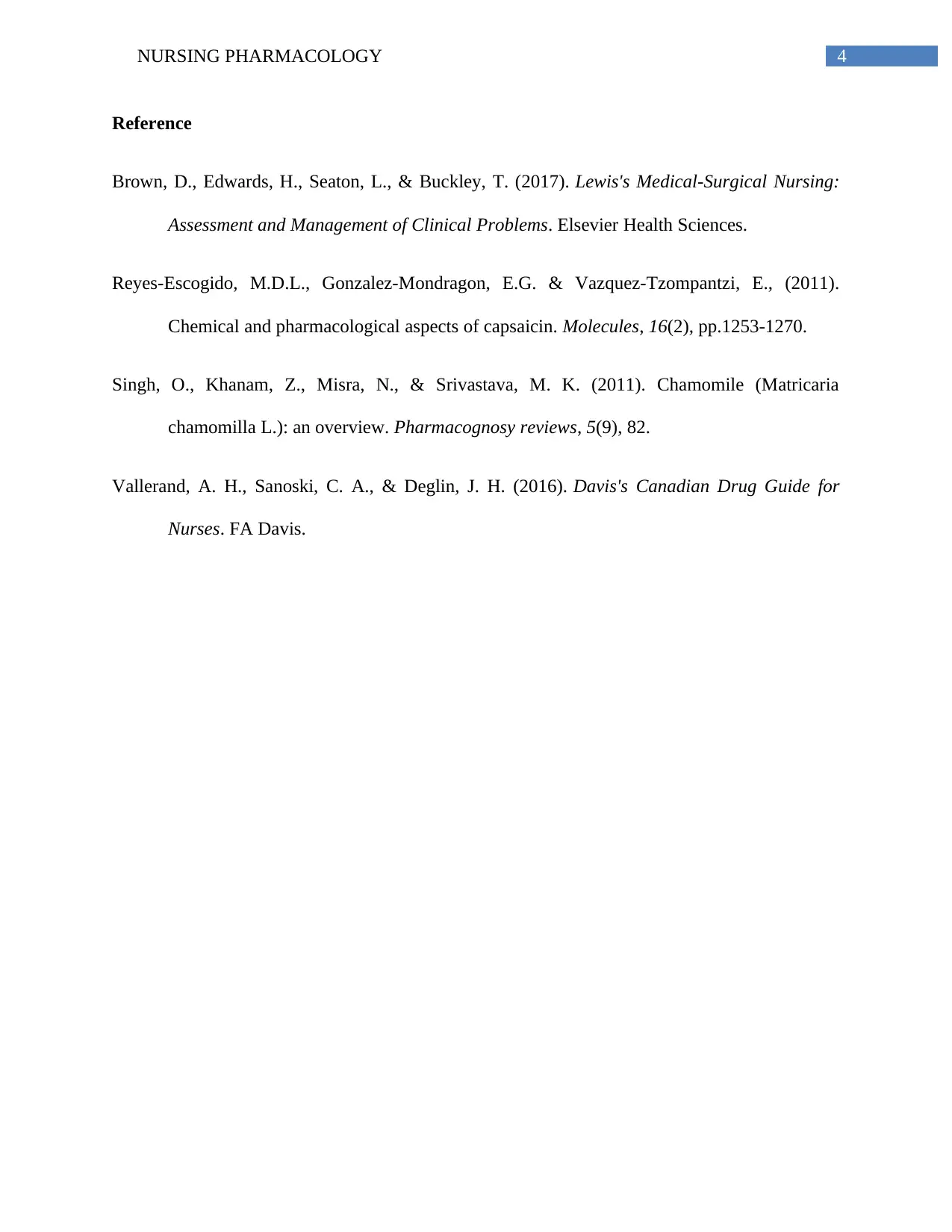
4NURSING PHARMACOLOGY
Reference
Brown, D., Edwards, H., Seaton, L., & Buckley, T. (2017). Lewis's Medical-Surgical Nursing:
Assessment and Management of Clinical Problems. Elsevier Health Sciences.
Reyes-Escogido, M.D.L., Gonzalez-Mondragon, E.G. & Vazquez-Tzompantzi, E., (2011).
Chemical and pharmacological aspects of capsaicin. Molecules, 16(2), pp.1253-1270.
Singh, O., Khanam, Z., Misra, N., & Srivastava, M. K. (2011). Chamomile (Matricaria
chamomilla L.): an overview. Pharmacognosy reviews, 5(9), 82.
Vallerand, A. H., Sanoski, C. A., & Deglin, J. H. (2016). Davis's Canadian Drug Guide for
Nurses. FA Davis.
Reference
Brown, D., Edwards, H., Seaton, L., & Buckley, T. (2017). Lewis's Medical-Surgical Nursing:
Assessment and Management of Clinical Problems. Elsevier Health Sciences.
Reyes-Escogido, M.D.L., Gonzalez-Mondragon, E.G. & Vazquez-Tzompantzi, E., (2011).
Chemical and pharmacological aspects of capsaicin. Molecules, 16(2), pp.1253-1270.
Singh, O., Khanam, Z., Misra, N., & Srivastava, M. K. (2011). Chamomile (Matricaria
chamomilla L.): an overview. Pharmacognosy reviews, 5(9), 82.
Vallerand, A. H., Sanoski, C. A., & Deglin, J. H. (2016). Davis's Canadian Drug Guide for
Nurses. FA Davis.
1 out of 5
Related Documents
Your All-in-One AI-Powered Toolkit for Academic Success.
+13062052269
info@desklib.com
Available 24*7 on WhatsApp / Email
![[object Object]](/_next/static/media/star-bottom.7253800d.svg)
Unlock your academic potential
Copyright © 2020–2025 A2Z Services. All Rights Reserved. Developed and managed by ZUCOL.





